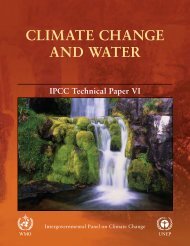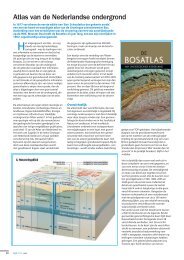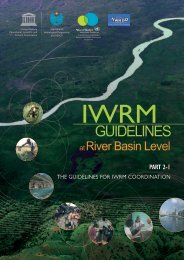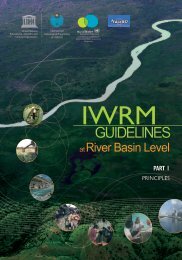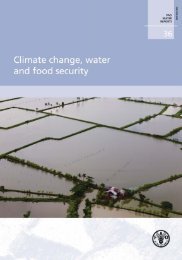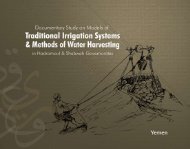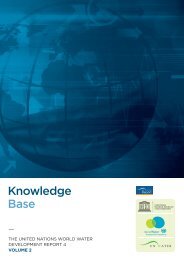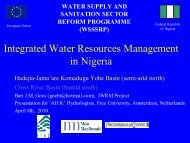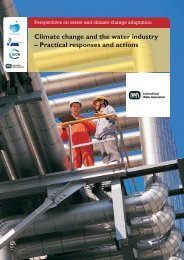Guide to Hydrological Practices, 6th edition, Volume II - Hydrology.nl
Guide to Hydrological Practices, 6th edition, Volume II - Hydrology.nl
Guide to Hydrological Practices, 6th edition, Volume II - Hydrology.nl
Create successful ePaper yourself
Turn your PDF publications into a flip-book with our unique Google optimized e-Paper software.
<strong>II</strong>.3-12GUIDE TO HYDROLOGICAL PRACTICESmore reasonable length of time, identify the mostimportant priorities for action, and thereby meetthe needs of managers and users (Mitchell, 1990).3.6.2 Vision for a desirable futureIntegrated water resources management is a means<strong>to</strong> an end, not an end <strong>to</strong> itself. As a result, before itsimplemention, or as an initial step in such a process,it is important <strong>to</strong> have a well-established visionor direction about a desired future condition for anarea or catchment. Integrated water resourcesmanagement will be one instrument <strong>to</strong> assist in itsachievement.A vision articulates the destination <strong>to</strong>wardswhich a group or society agrees <strong>to</strong> aim. Thevision represents a future which in significantways is better or more desirable than the present.Without such direction, it is difficult <strong>to</strong> determinewhich parts need <strong>to</strong> be brought <strong>to</strong>getherin<strong>to</strong> a whole, and who should be working<strong>to</strong>gether <strong>to</strong> arrange a proper order and establishrelationships.Developing a shared vision can be a major challenge,since at any given time a range of values,interests and needs will exist among different stakeholdergroups in a river basin or catchment.However, if there is no sense of direction, or clearlydefined ends, integrated water resources managementwill not be able <strong>to</strong> create one. Thus, plannersand managers must understand that without avision it is u<strong>nl</strong>ikely that integrated water resourcesmanagement will be an effective <strong>to</strong>ol. Even worse,it may be discredited because it did not deliver avision, something it was never intended <strong>to</strong> do.When thinking about a vision for the future, it ishelpful <strong>to</strong> distinguish among what is most probable,desirable and feasible. Planners and managersoften focus first on identifying most probablefutures, and insight on this is very valuable.However, <strong>to</strong>o often, they s<strong>to</strong>p there, or then movedirectly <strong>to</strong> considering what would be feasiblefutures, in light of what is deemed as most probable.An important point <strong>to</strong> remember is that themost probable future may not be the most desirablefuture; that is precisely why planners and managersseek <strong>to</strong> create a vision – <strong>to</strong> determine the desiredfuture condition.3.6.3 Spatial scale: watershed, subwatershed,tributary and siteIt is important <strong>to</strong> make a distinction among differentsituations when applying integrated waterresources management. The need <strong>to</strong> adjust theamount of detail included as spatial scale changes isespecially significant. In a report focusing on lessonslearned and best practices related <strong>to</strong> watershedmanagement, three Ontario conservation authorities(2002) shared some interesting insights.In Ontario, watershed planning, equivalent <strong>to</strong>integrated water resources management, isconducted on four different scales, “with the levelof detail increasing as the size of planning areadecreases”. In that context, the most logical andefficient way <strong>to</strong> conduct integrated water resourcesmanagement is <strong>to</strong> start with a catchment or riverbasin plan, then develop sub-catchment or subwatershedplans on a priority basis, andsubsequently follow those with tributary plans,and finally with environmental site plans, asappropriate. Key lessons indicate that what is doneat each stage provides direction and informationfor the next lower level and also helps avoid orminimize the potential for duplication.However, financial constraints often result in subbasinor sub-watershed plans being prepared first,and integrated later in<strong>to</strong> an overall basin or catchmentplan for integrated water resourcesmanagement. In a similar way, tributary plans maybe completed before the sub-catchment plans. Thethree Canadian conservation authorities distinguishamong the four levels of integrated waterresources management in the following ways:(a) Basin or catchment plans: Such plans cover largeareas. These plans include goals, objectives andtargets for the entire basin and document bothenvironmental resources and environmentalproblems. They also provide catchment-widepolicy and direction for protecting surface andgroundwater, natural features, fisheries, openspace systems, terrestrial and aquatic habitats,and other important features;(b) Sub-basin or sub-catchment plans: These plansinvolve a smaller area compared with the basinor catchment level plan. On this spatial scale,enhanced detail is provided <strong>to</strong> allow localenvironmental issues <strong>to</strong> be addressed. Goals,objectives and targets for management of thesub-catchment are identified. Sub-basin or subcatchmentplans dealing with integrated waterresources management are cus<strong>to</strong>m designed<strong>to</strong> reflect local conditions and concerns.Recommendations may be included subsequentlyin official plans, secondary plans,growth management plans or other municipalplanning instruments;(c) Tributary plans: Plans on this scale are usuallyprepared <strong>to</strong> guide proposals for significant land





